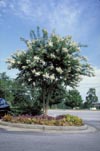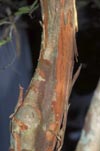Home >
Lagerstroemia x 'Natchez',
Natchez Crapemyrtle
'Natchez' grows best in full sun with rich, moist soil but will tolerate less hospitable positions in the landscape just as well, once it becomes established. However, plants left on their own in highway medians appear to be less vigorous unless ample mulch is applied and maintained out to the drip line. The best plants are often located in irrigated landscapes. Plants defoliate in severe drought but new foliage and flowers typically emerge when summer rain returns.
Flowers are produced for about 90 days on this cultivar. This is one of the most popular cultivars, but could be used more as a small shade tree, street tree or parking lot tree. Flowers are produced for much of the summer lasting more than 100 days in some years. This tree is best when left to grow into a tree and not hacked back each year. It grows well in limited soil spaces in urban areas such as along boulevards, in parking lots, and in small pavement cutouts if provided with some irrigation until well established. They tolerate clay and alkaline soil well. This plant is considered mostly allergy free and causes little or no allergy problems in most people. 'Natchez' is one of the few cultivars well suited for the southern portion of Florida.
Many crapemyrtles, but not this one, are magnets for a host-specific aphid that only infests crapemyrtle, not other plants. The damage this causes is not lethal to crapemyrtle. Many beneficial insects which feed on pests that damage other landscape plants use this aphid for food. In this way, the crapemyrtle aphid serves as prey for beneficial insects. Therefore, planting crapemyrtle that attract aphids can enhance biological control of insect pests on other plants in the landscape.
New growth can be pinched during the growing season to increase branchiness and flower number. You can remove spent flower heads following the first flower display to encourage a second flush of flowers and to prevent formation of the brown fruits. Spent flower heads and developing fruits can be removed in the fall after several cold fronts have passed through the region and there is no danger of plants sprouting new growth until spring. A nice effect can be obtained by cutting current year's stems in late winter to balance and tidy-up the canopy. Be sure to reduce the length of branches extending outside the edge of the canopy outline. This produces a denser canopy and presents a neater appearance compared to trees that are not pruned. Topping branches more than a year old or more than a half inch diameter disfigures the nice trunk and branch structure on crapemyrtles.
Severe pruning or topping can stimulate basal sprouting which can become a constant nuisance, requiring regular removal. Some trees sprout from the base of the trunk and roots even without severe heading. This can be a maintenance nuisance. Materials containing NAA (auxin) are occasionally used on the trunk to minimize sprouting.
Recent
research shows that trees that are severely topped or headed by cutting
back into wood that is more than a year old causes increased sprouting
from the base of the trunk, larger flowers, fewer flowers and delays flowering
two or three weeks. Branches also droop toward the ground in the rain.
The best looking form on crape myrtle develops by pruning back to pencil
sized twigs each year. This pruning is performed with a hand pruner or
lopper on small plants or a lopper mounted on a pole for larger trees.
Pollard plants also look very nice. The best time to prune crape myrtle
is toward the middle or end of the dormant period. Pruning too early will
stimulate sprouting behind the cuts and make the tree susceptible to cold
damage.




